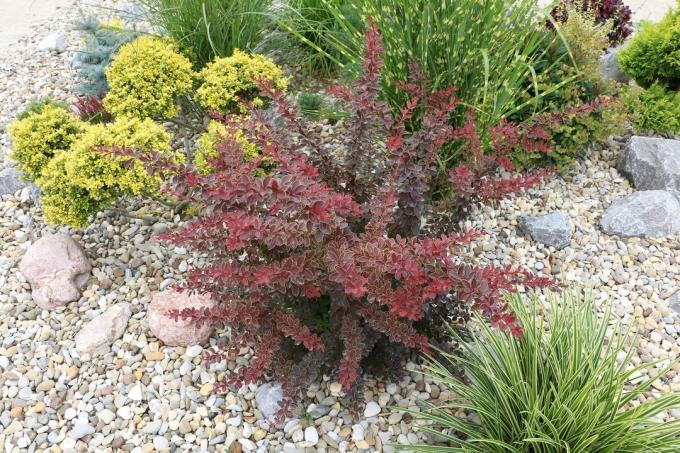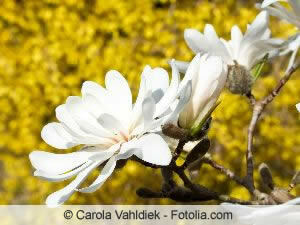

Table of contents
- planning
- Preparation
- Investment tips
- planting
- Care
- cleaning
- Suitable plants - overview
- Tips for beautiful gravel gardens
- Conclusion
Luxurious and decorative or rustic, wild and rough - a gravel garden offers numerous design options and can add a highlight to your own green space. Beginners therefore often shy away from the artfully laid out gravel beds, but their easy-care properties make them ideal for them. Provided, of course, that a number of factors are taken into account when planning and laying out the bed. Otherwise, at the latest, cleaning becomes a problematic matter that can spoil the fun of the gravel bed.
planning
If you want to make it easier to create the gravel bed, look for an area in the garden with loamy, sandy or gravelly soil. The effort is particularly low here, the strenuous excavation and mixing of the substrate can be completely dispensed with. If such an area is not available, the gravel bed can still be realized.
However, as early as the planning stage, it must be taken into account that a layer at least 20 to 30 centimeters high must be removed. If there are tree roots or adjacent shrubs and hedges whose roots run into the future gravel bed, this could damage the plants. In addition, the falling leaves in large quantities make cleaning more difficult. The ideal place for a gravel garden is therefore:
- Free from larger roots
- Away from deciduous plants
- Can be clearly demarcated
In addition, the conditions at the site should of course match the requirements of the desired plants. For the rest of the planning of the gravel garden, a sketch is sufficient, which includes the scope and paths, any boundaries and the plants themselves.
Preparation
Before the gravel bed itself is created, the area must be prepared accordingly. If the soil is already well drained with sand or gravel, the effort is low. Only the following steps are necessary here:
- Dig up or loosen up the upper layers of the future bed.
- Carefully remove weeds and roots.
- If desired, separate the bed from the outside with lawn edging stones.
Once these steps are complete, the actual docking can begin. With moist, compacted soil, a little more effort is required. The procedure here is as follows:
- The desired area – again including the roots – is freed from weeds.
- The bed is dug up deeply.
- The top 20 to 30 centimeters are removed and mixed well with sand or fine gravel. Depending on the nature of the substrate, one part soil can be mixed with one part loosening material. In addition, and depending on the subsequent planting, part of the compost should also be mixed in.
- The substrate that has been loosened in this way is returned to the bed and gently pressed down to create an even surface.
- Lawn edging stones can again be used for demarcation.
Investment tips
After the bed has been prepared accordingly, the actual laying out of the gravel garden can proceed. The direct application of the gravel is not advisable. Instead, a weed fleece should be applied that does not rot but allows water and air to pass through. The growth of unwanted plants is suppressed and stones are prevented from being washed out. This barrier between earth and stones makes sense on several levels and makes subsequent care easier.
If several pieces have to be used when laying out, they should overlap at least a hand's breadth. A little more is better so the weight of gravel or grit doesn't cause gaps in coverage. The paths are then laid out if special running routes are planned in the gravel garden. Flat, larger stones or finer decorative chippings can also be used for these. So that the edges of the paths do not "blur", they should be limited. Medium-sized stones or low lawn stones are well suited for this. If lawn catwalks are to be used, the fleece can be cut open with a sharp knife or laid later.
As soon as the paths are finished, the planting and the first layer can follow. If coarse decorative grit is used as the bottom layer, this forms a visual finish and covers the fleece well and evenly. In addition, the split is cheaper and therefore recommended for larger gravel beds and a small budget. Coarse gravel is placed on this bottom layer. How high this layer can and should be depends on the preferred type of planting. In advance, when planning and buying the material, it should be clear what will grow later in the gravel garden and how it will be used.
planting
There are basically two options for planting in the gravel garden. On the one hand, the plants can be used in pots and tubs. This type of planting is recommended for plants that are not hardy. In addition, hobby gardeners do not have to decide what should grow in the gravel bed, changes can be made easily and without any problems. However, the watering then becomes a bit more complex, since the plants cannot take care of themselves via the substrate.
If you decide to plant the gravel garden directly and permanently, you have to start after laying out the weed fleece. To do this, proceed as follows:
- Crosses are cut into the fleece at the desired points with a sharp knife.
- The corners are opened and the substrate is dug out to match the size of the root ball.
- The crop is used, the earth pressed down.
- The fleece is placed over it as close as possible.
- The first layer is applied. Care must be taken to avoid damaging the plants.
- Watering is only carried out when all the gravel has been spread.
Care
If the soil has been prepared accordingly, regular watering is all that is needed to care for the plants in the gravel bed. However, this is only during the first year. After that, only water when needed. Since rain can easily pass through gravel, grit and fleece, but the layers significantly reduce evaporation, the plants can largely take care of themselves. An exception here are of course plants that are in tubs or pots.
Is fertilized via the irrigation water.
cleaning
Larger dirt, such as leaves and twigs, are collected on the gravel or read off by hand. A leaf vacuum or leaf blower can also be used. If finer accumulations of dirt appear, the surface of the gravel can be turned or simply moved so that the dirt sinks downwards - i.e. disappears from the field of vision.
Only if these measures do not help does the gravel bed filling have to be removed and replaced or cleaned with high water pressure.
Suitable plants - overview
Depending on the flair that the gravel garden should exude, the plants must also be selected appropriately. It gets Mediterranean with:
- lavender
- rosemary
- pearl basket
- globe thistle
- cistus
- Mediterranean Spurge
- curry herb
- Tall bearded iris
For an exotic, minimalist impression, however, cacti and succulents, among others, are recommended. If these are to be planted directly in the gravel bed, attention must of course be paid to the winter hardiness of the respective species and breed. Are suitable:
- agaves
- yucca
- opuntias
- sempervivum
- aloe vera
If, on the other hand, it should be a gravel garden in the style of Japanese plants, a compilation of the following plants can be in the gravel bed:
- bamboo
- China reed
- Japanese maple
- anemones
- flower dogwood
- dwarf lilac
- magnolias
- ornamental cherry

On the other hand, rock garden plants such as stonecrop, catnip, stonecrop and saxifrage are more traditional for the temperate climate zone.
Tips for beautiful gravel gardens
- If you want to cover a larger area, you should choose gravel of the size 16/32. The advantage here is that the stones are heavy enough to z. B. Clearing leaves with no problems. A disadvantage can be that large cavities are created in which the leaves get caught.
- To prevent weeds from spreading, a dumping height of six to eight centimeters is required.
- If you want to create a free-form bed, we recommend laying out a garden hose first and moving it around until you have the shape you want. It is often recommended to put foil underneath to reduce weed pressure.
- A curb made of bricks, wood or stones prevents the fill from slipping off into the lawn. When planting, you should start with the long-lived and tall varieties. Depending on the season, short-lived varieties are then placed in the gaps. Before planting, you should immerse each pot in water until no more air bubbles rise and the pots sink. This ensures good watering right from the start and thus good growth.
Conclusion
Whether a small gravel bed or a large gravel garden, flat or with small hills - the special eye-catcher is an easy-care ornament with proper planning and well thought-out creation. Minimalist or lavish, it always offers a lot of creative freedom, saves water and effort. It is therefore also unreservedly recommended for beginners.
 garden editorial
garden editorial I write about everything that interests me in my garden.
Find out more about front yard & Co

Extensive green roof | 7 tips on structure, plants & costs
Green roofs can make an important contribution to improving air quality in cities. The indoor climate in the rooms below is also improved. Where a green roof is possible with which plants and what the structure looks like is here.

Creating a forest garden: 11 plants for a forest plot
Creating a forest garden is the dream of many nature lovers. What could be more enticing than finding pure relaxation right on your doorstep? If you want to design a forest garden, you need a lot of patience and good planning. We have put together some tips.

Zen garden - create meaning and miniature garden yourself
The Zen garden helps to clear your head; The indoor version of the miniature Zen garden finds its place in every household - there is enough trouble in everyday life, in the article you will learn how to create your own relaxation oasis.
Cottage garden - planning and design + planting plan
The cottage garden is a rural garden from England, similar to our cottage gardens, only finer, more filigree, with great attention to detail. The garden is planned very precisely, but in the end it has to appear as if everything had happened quite by accident, quite naturally. The cottage garden was initially laid out around a cottage (house). The house plays a subordinate role today. The basic ingredients and design rules are important.

Create an easy-care front yard
The front yard is easily visible from the outside, especially in an urban environment, and is therefore a kind of presentation platter, which is conscientiously designed and maintained by hobby gardeners. We look into the question of how to make the care of the front garden easier.

Creating a terraced house garden - planning and design
In a terraced house garden, the design options are usually limited. With careful planning and layout, you can also accommodate a lot here and design the garden creatively. An important and central point in every garden is a comfortable seating area. Small terraces with little space can be upgraded and beautified with a wooden deck.



